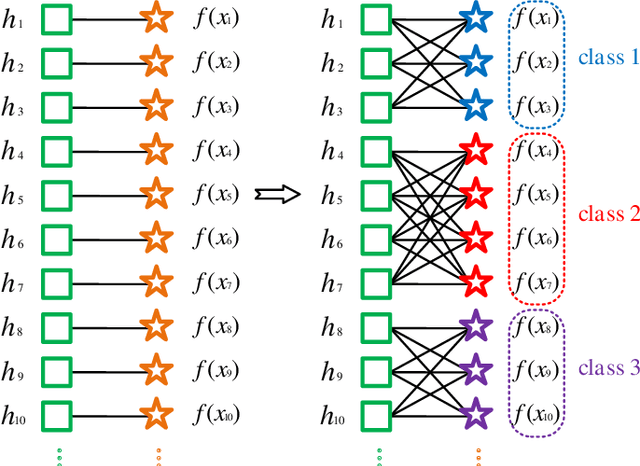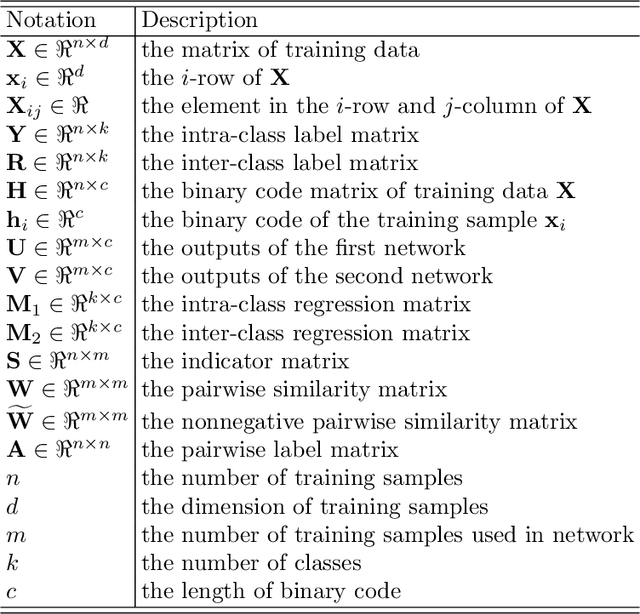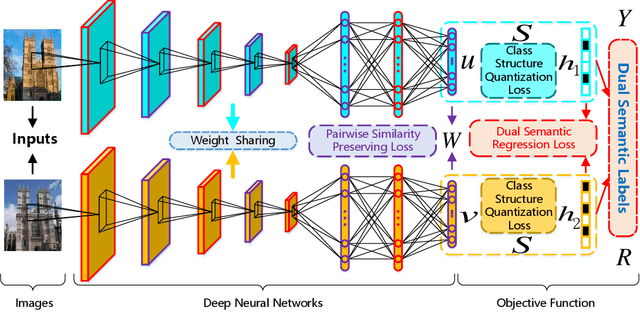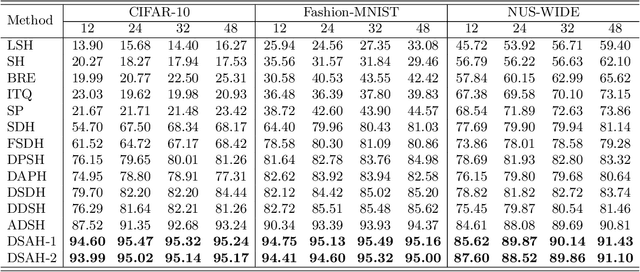Jiajun Wen
EPL: Empirical Prototype Learning for Deep Face Recognition
May 21, 2024Abstract:Prototype learning is widely used in face recognition, which takes the row vectors of coefficient matrix in the last linear layer of the feature extraction model as the prototypes for each class. When the prototypes are updated using the facial sample feature gradients in the model training, they are prone to being pulled away from the class center by the hard samples, resulting in decreased overall model performance. In this paper, we explicitly define prototypes as the expectations of sample features in each class and design the empirical prototypes using the existing samples in the dataset. We then devise a strategy to adaptively update these empirical prototypes during the model training based on the similarity between the sample features and the empirical prototypes. Furthermore, we propose an empirical prototype learning (EPL) method, which utilizes an adaptive margin parameter with respect to sample features. EPL assigns larger margins to the normal samples and smaller margins to the hard samples, allowing the learned empirical prototypes to better reflect the class center dominated by the normal samples and finally pull the hard samples towards the empirical prototypes through the learning. The extensive experiments on MFR, IJB-C, LFW, CFP-FP, AgeDB, and MegaFace demonstrate the effectiveness of EPL. Our code is available at $\href{https://github.com/WakingHours-GitHub/EPL}{https://github.com/WakingHours-GitHub/EPL}$.
SemiPL: A Semi-supervised Method for Event Sound Source Localization
Apr 30, 2024



Abstract:In recent years, Event Sound Source Localization has been widely applied in various fields. Recent works typically relying on the contrastive learning framework show impressive performance. However, all work is based on large relatively simple datasets. It's also crucial to understand and analyze human behaviors (actions and interactions of people), voices, and sounds in chaotic events in many applications, e.g., crowd management, and emergency response services. In this paper, we apply the existing model to a more complex dataset, explore the influence of parameters on the model, and propose a semi-supervised improvement method SemiPL. With the increase in data quantity and the influence of label quality, self-supervised learning will be an unstoppable trend. The experiment shows that the parameter adjustment will positively affect the existing model. In particular, SSPL achieved an improvement of 12.2% cIoU and 0.56% AUC in Chaotic World compared to the results provided. The code is available at: https://github.com/ly245422/SSPL
SFMViT: SlowFast Meet ViT in Chaotic World
Apr 25, 2024Abstract:The task of spatiotemporal action localization in chaotic scenes is a challenging task toward advanced video understanding. Paving the way with high-quality video feature extraction and enhancing the precision of detector-predicted anchors can effectively improve model performance. To this end, we propose a high-performance dual-stream spatiotemporal feature extraction network SFMViT with an anchor pruning strategy. The backbone of our SFMViT is composed of ViT and SlowFast with prior knowledge of spatiotemporal action localization, which fully utilizes ViT's excellent global feature extraction capabilities and SlowFast's spatiotemporal sequence modeling capabilities. Secondly, we introduce the confidence maximum heap to prune the anchors detected in each frame of the picture to filter out the effective anchors. These designs enable our SFMViT to achieve a mAP of 26.62% in the Chaotic World dataset, far exceeding existing models. Code is available at https://github.com/jfightyr/SlowFast-Meet-ViT.
HDBN: A Novel Hybrid Dual-branch Network for Robust Skeleton-based Action Recognition
Apr 25, 2024



Abstract:Skeleton-based action recognition has gained considerable traction thanks to its utilization of succinct and robust skeletal representations. Nonetheless, current methodologies often lean towards utilizing a solitary backbone to model skeleton modality, which can be limited by inherent flaws in the network backbone. To address this and fully leverage the complementary characteristics of various network architectures, we propose a novel Hybrid Dual-Branch Network (HDBN) for robust skeleton-based action recognition, which benefits from the graph convolutional network's proficiency in handling graph-structured data and the powerful modeling capabilities of Transformers for global information. In detail, our proposed HDBN is divided into two trunk branches: MixGCN and MixFormer. The two branches utilize GCNs and Transformers to model both 2D and 3D skeletal modalities respectively. Our proposed HDBN emerged as one of the top solutions in the Multi-Modal Video Reasoning and Analyzing Competition (MMVRAC) of 2024 ICME Grand Challenge, achieving accuracies of 47.95% and 75.36% on two benchmarks of the UAV-Human dataset by outperforming most existing methods. Our code will be publicly available at: https://github.com/liujf69/ICMEW2024-Track10.
Deep Asymmetric Hashing with Dual Semantic Regression and Class Structure Quantization
Oct 24, 2021



Abstract:Recently, deep hashing methods have been widely used in image retrieval task. Most existing deep hashing approaches adopt one-to-one quantization to reduce information loss. However, such class-unrelated quantization cannot give discriminative feedback for network training. In addition, these methods only utilize single label to integrate supervision information of data for hashing function learning, which may result in inferior network generalization performance and relatively low-quality hash codes since the inter-class information of data is totally ignored. In this paper, we propose a dual semantic asymmetric hashing (DSAH) method, which generates discriminative hash codes under three-fold constrains. Firstly, DSAH utilizes class prior to conduct class structure quantization so as to transmit class information during the quantization process. Secondly, a simple yet effective label mechanism is designed to characterize both the intra-class compactness and inter-class separability of data, thereby achieving semantic-sensitive binary code learning. Finally, a meaningful pairwise similarity preserving loss is devised to minimize the distances between class-related network outputs based on an affinity graph. With these three main components, high-quality hash codes can be generated through network. Extensive experiments conducted on various datasets demonstrate the superiority of DSAH in comparison with state-of-the-art deep hashing methods.
 Add to Chrome
Add to Chrome Add to Firefox
Add to Firefox Add to Edge
Add to Edge